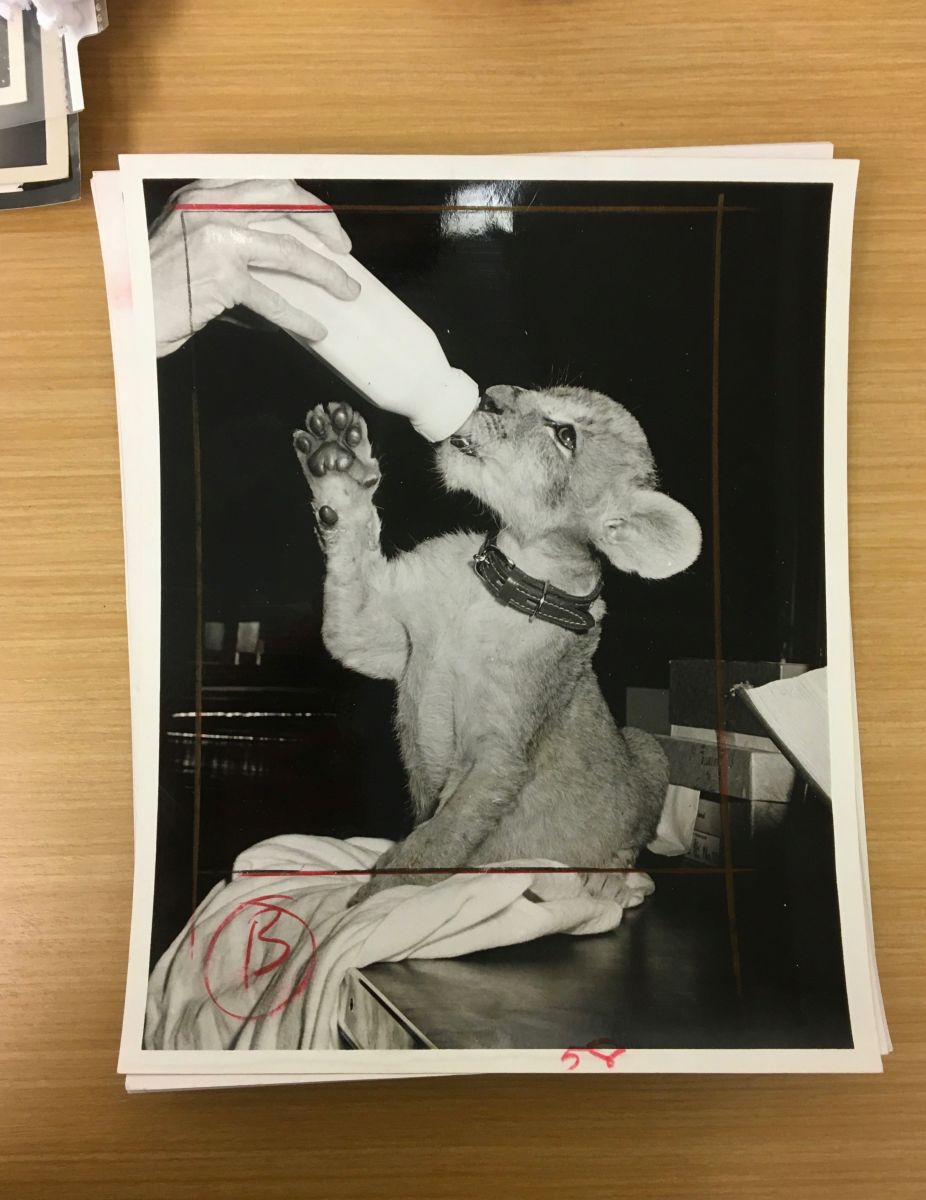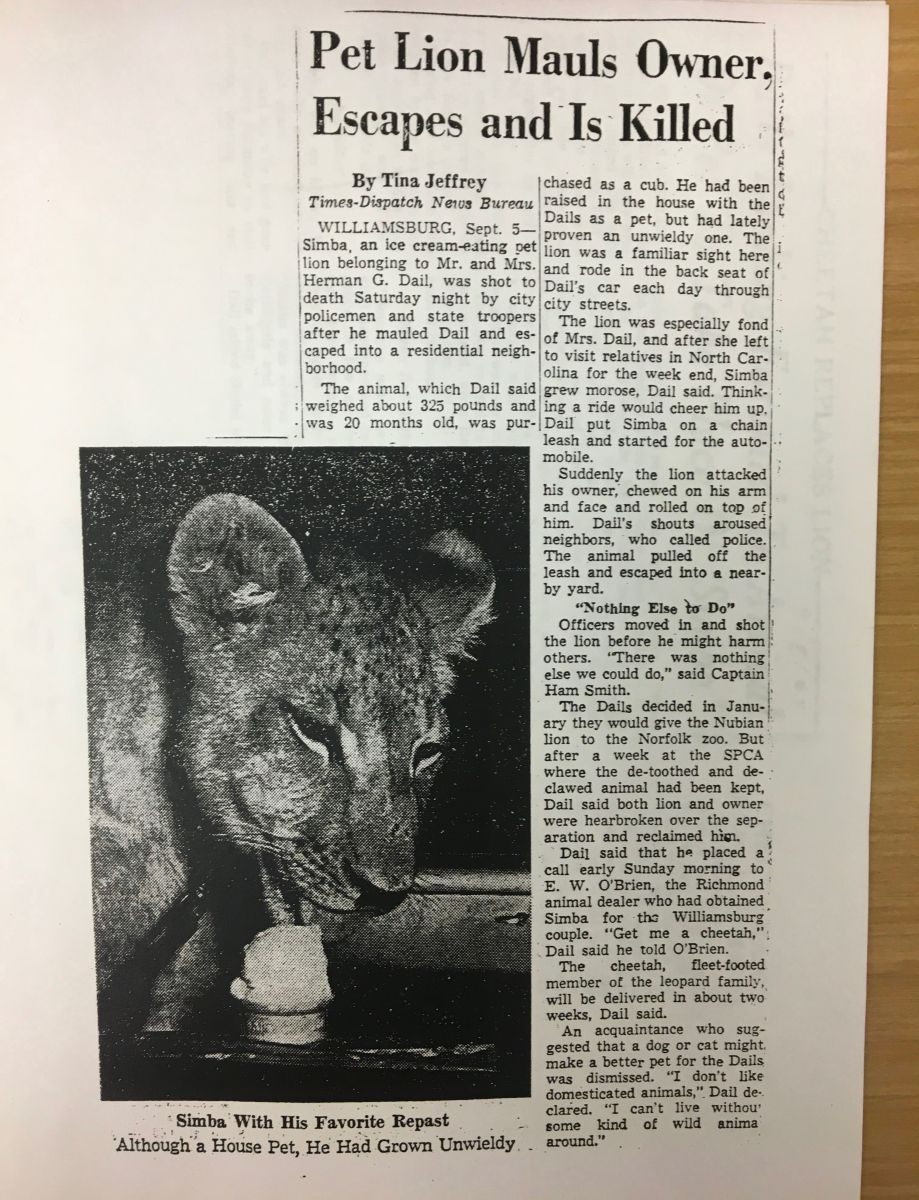“Simba Answers Call of the Wild”
Maria DiBenigno, Special Collections accessioning and processing assistant, shares a story of an exotic pet documented in a recent addition to the Thomas L. Williams Collection. Read on to learn more about Simba, a lion who lived in Williamsburg.

During this time of quarantine, we might hold close the ones we love: family, friends, and pets. In one recent Netflix docuseries, some of us learned about households with exotic pets – broadly defined as non-native and non-domesticated. People have kept these animals for thousands of years but in the mid-twentieth century several new species gained popularity in the United States. According to some reports, there are approximately 400 million domestic and exotic pets in the United States but it is hard to get accurate numbers due to inadequate regulation, lack of honest reporting, and illegal trading and/or sale. Simply searching Google reveals the potential dangers in keeping certain exotic pets – dangers that pertain to both humans and animals. A recent addition to the Thomas L. Williams Collection (MS 00254, Acc. 2020.024) reveals one cautionary tale about exotic pet ownership here in Williamsburg, Virginia.
Over Labor Day weekend in 1965, a twenty-month old male lion cub named Simba made national news in newspapers from California to Connecticut. The story began when a self-employed Williamsburg painter, Herman G. Dail, purchased the cub from Richmond animal dealer, E.W. O’Brien. Simba lived with Dail and his wife Annie on Scotland Street, not far from Colonial Williamsburg’s Historic Area. Williamsburg-area photographer Thomas L. Williams took many pictures of Simba being bottle-fed, sitting in the backseat of a car, and enjoying an ice cream cone. In January 1965, Simba grew too large for his Williamsburg home and was given to the Norfolk Zoo only to be reclaimed by the Dails after he appeared “heartbroken over the separation.” Apparently, Simba was not eating.

On Saturday, September 4, 1965, Dail tried to take Simba on a drive around the neighborhood. He wanted to cheer up the lion cub who had been “moaning and groaning” all day and car rides seemed to comfort the animal. Instead, Simba broke free from his chain leash, mauled Dail’s upper body (Dail was not seriously injured), and ran off into the night. Upon hearing Dail’s screams, neighbors called the police, and Simba was eventually shot and killed by city policemen and state troopers. According to newspaper accounts, Dail telephoned O’Brien the morning after Simba’s death to request a cheetah.
Though the majority of big cats are kept in Florida, Texas, and California, Virginia ranks 18th in the country for documented possession of cheetahs, tigers, and lions. Currently, the Commonwealth has a partial ban on big cat ownership. According to state law, “persons may possess these animals [non-native, predatory, and undesirable as a pet] if they are a licensed exhibitor, i.e. commercial, educational or scientific uses.” It attempts to address public safety, wildlife conservation, and the animal’s quality of life. Under these requirements, Dail would be ineligible for a permit.


Please note that the materials referenced here are unprocessed and not yet readily available to researchers. If you are interested in viewing these materials, please contact the Special Collections Research Center at spcoll@wm.edu.
Resources and More to Explore:
Discover more from the Thomas L. Williams Collection (MS 00254) on the SCRC's Manuscripts and Archives Collection Guides database.
Explore the range of animal studies and relevant resources from W&M Libraries on the Animal Studies Research Guide.
Learn more about the life and photography of Thomas L. Williams on the Special Collections wiki.
W&M users can search for more news articles related to Simba and Dail through W&M Libraries' subscription to Newspapers.com.

